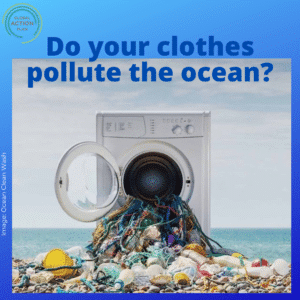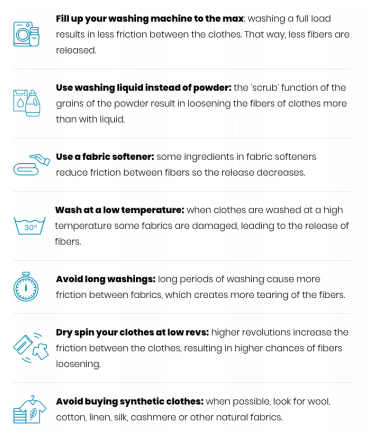
Are your clothes polluting the ocean?
Many of the biggest threats to our natural environment are hard to see. Acid rain, greenhouse gases, toxic fumes; we are slowly getting used to invisible dangers.
And one of the biggest threats we are facing now is also one that cannot be seen with the naked eye. This pollutant is so small, you need a microscope to see it. We are talking about microfibres.
What are microfibres?
You might be surprised to know that the most of our clothes are actually made of plastic. Or maybe you already realised that most modern clothing is made from synthetic material, like polyester, acrylic, or nylon. (Click here to read more about Fast Fashion and synthetic materials)
Synthetic clothes are cheaper to make, stronger, mire resistant to stains and more versatile. But they also have a major downside: Making them comes at a big cost to the global climate, and they turn out to be a major source of plastic pollution:
Every time you wash these clothes, little microscopic bits come off and get rinsed away down the drain. These small bits of plastic, usually less than a millimetre in length and thinner than a human hair, are called “microfibres”.
Every time we do our laundry, an average 9 million microfibres are washed away.
How do these microfibres damage the planet?
The microfibres from our clothes are washed into our waste water treatment systems. But because they are so small, they cannot be detected or filtered out, and they end up in our waterways and, ultimately, the ocean.
It is estimated that about one-third of the plastic in our oceans is made up of microfibres.
The microscopic pollution affects even the tiniest sea creatures, who absorb it in their food. As the smaller fish are eaten by larger fish, the plastic enters the food chain.
In fact, in March 2022 it was reported that scientists have found microplastics in human blood!
The microscopic particles were discovered in 77% of the healthy adult blood donors tested.
Scientists also found that the faeces of babies contained about 10 times more microplastics than that of adults, as babies are often fed with plastic bottles and tend to be more vulnerable to chemical exposure.
How many microfibres are there in the ocean?
Approximately 2 million tonnes of microfibres are released into the ocean every year.
It’s already estimated there are 200 million microfibres for every person on the planet. That’s an incomprehensible 1.4 million trillion fibres in our oceans.
What you can do to help reduce microfibres
Our friends at Ocean Clean Wash have developed a helpful list with tips and suggestions on what we can do at home to help reduce the problem.
To turn the tide on ocean pollution, clothing manufacturers can take a few simple steps to reduce their impact on our planet. But we, as consumers at home, can also play a role by:
- Installing a washing machine lint trap, washing in cold water, and only laundering clothes when necessary.
- Choosing to purchase clothing from brands that are leading the way in the fight against microfibre pollution.
- Supporting organisations like Ocean Wise that are undertaking research and finding practical solutions.




